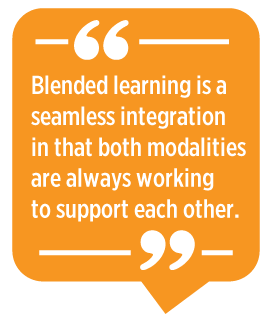|
 Hybrid, hyflex, flipped, face-to-face, remote learning…we
are now faced with so many instructional modalities. What they all have in
common is a mix of synchronous and asynchronous learning—in other words, some
real time and some independent online time.
Hybrid, hyflex, flipped, face-to-face, remote learning…we
are now faced with so many instructional modalities. What they all have in
common is a mix of synchronous and asynchronous learning—in other words, some
real time and some independent online time.
In a sense,
this is not new because, traditionally, students have always had a mix of classwork
and homework. If we use this as our starting point of common understanding, we
can easily move into blended learning—a mix of instructional modalities.
Blended learning can now be thought of as either a mixture of face-to-face with
online (traditional definition) or a mixture of real-time video chat (e.g.,
Zoom, Google Meet, or Teams) with online (more common now as a result of the
COVID-19 pandemic). Either way, blended learning can be optimized through
intentional planning of the instruction in the two modalities—synchronous and
asynchronous (McGee & Reis, 2012). See Figure 1 for a breakdown of
instructional modalities, from fully face-to-face to fully online.
Our
interpretation of blended learning is a
seamless integration in that both modalities are always working to support each
other. What students are doing independently online supports and
aligns with what is happening in the real-time classroom. The interactions of
learner-learner, learner-content, and learner-teacher seamlessly exist in both
modalities. Look at the vocabulary lesson presented in Appendix A to see how
content can be delivered differently and similarly in multiple
modalities.

|
In a fully synchronous classroom, students and instructors communicate and collaborate only through face-to-face interactions. Instruction does not use telephonic, postal, or other courier services to facilitate peer‑to‑peer or student‑instructor communication and collaboration. |
A blended classroom may include few or many ways for peer‑to‑peer and student‑instructor communication to occur. Classroom meetings may be solely face-to-face, or they may use remote learning techniques for some or all the students. Peer‑to‑peer student‑instructor communication and collaboration may occur in multiple ways, such as by sharing the same physical space, by post, or by using instant messaging apps on smartphones. Each decision regarding the use of remote education techniques is independent of other decisions and is made to increase student success. |
In a fully asynchronous classroom, all communication between students and instructors occurs remotely. This may include the use of computers and tablets, telephonic equipment, or the use of the postal service. |
Figure 1.
Course modalities.
In 2020,
because of the COVID-19 pandemic, blended learning came to the forefront as we
quickly shifted to online learning, but many times still maintained a
synchronous presence via video. Blended learning provided learners and teachers
with an array of opportunities. Learners reached greater possibilities of
independent learning while still having the support of the instructor through
real-time video chats. This was many times a difficult and challenging process
as educators were pushed into new and sometimes uncomfortable realms. We
learned new technologies and techniques to create an engaging blended
environment.
Course Design and Delivery in Blended Learning
Traditionally, blended learning
allows for more flexibility in terms of time and collaboration and has been
understood as course delivery—in other words, how we deliver and teach a
course. But it should also be thought of as course design—in other words, how
we imagine and build the course from the beginning. Shifting the focus to
course design first to determine the right blend of time can make delivery more
intentional. Intentional course design is a key focus in a flexible blended
format.
Hybrid and
flipped learning are commonly delivered at time ratios of 50/50 for in-class
and out-of-class work. However, that may not be the optimal blend of time for
all students, contexts, and courses. The right blend of time involves
intentional design and alignment of course elements, technologies, and
interactions between learners, teacher, and materials. One way to look at this
is by determining whether content and activities need to take place online
asynchronously or in the synchronous environment (Chatfield, 2010).
 We can
examine it in more detail by looking at what needs to occur before the
synchronous meeting, during the synchronous meeting, and after the synchronous
meeting. For example, readings and videos might be assigned prior to class to
get students activating their background knowledge. Then, in-class activities
could focus on discussions and collaborations. Follow-up online activities
could be self-assessments, summaries, and synthesizing information.
Alternatively, a context might require that students need more teacher
explanation and feedback in the synchronous time, and discussions and
collaborations occur in the asynchronous environment. We can
examine it in more detail by looking at what needs to occur before the
synchronous meeting, during the synchronous meeting, and after the synchronous
meeting. For example, readings and videos might be assigned prior to class to
get students activating their background knowledge. Then, in-class activities
could focus on discussions and collaborations. Follow-up online activities
could be self-assessments, summaries, and synthesizing information.
Alternatively, a context might require that students need more teacher
explanation and feedback in the synchronous time, and discussions and
collaborations occur in the asynchronous environment.
When and
where content occurs will be specific to the class, the modality, the level of
the students, and the expectations of interactions. Lower level students or
students early in a course may need more content presented in class initially
with more online work as a follow-up to the in-class presentation and
activities. Later, students may become more independent within the course and
be able manage self-directed learning by taking on more responsibility for the
coursework up front. Then, class time can focus on group work, hands-on
projects, and student teaching.
Be creative!
Teaching can take place in class or online, depending on the nature of the
task. The content should be intentionally designed to occur synchronously or
asynchronously.
Planning for Blended Learning: The Right Blend of Time
So how do
you decide? How do you plan? To begin, we recommend mapping out course elements
and design while also allowing for built-in flexibility. The map will be your
guide and allow you to build lesson plans and the course itself. This results
in the right blend of time, which is the ratio of in-class/online or
synchronous/asynchronous work. For some classes, it still may be a 50/50 ratio;
other classes could result in more time spent in class, such as 60% in class
and 40% online (or 60/40), while others may result in less in-seat time, such
as 40% in class and 60% online (or 40/60).
For example,
let’s consider a lower intermediate course at a community college where many
students come from countries without technology access. Based on these factors,
a blended course that allows for about 70% face-to-face instruction will allow
the students to engage in more listening and speaking interactions while also
developing independence and confidence in online, independent work. In
contrast, suppose you have a course of international scholars with advanced
degrees from their home countries; these students are self-regulating and
highly motivated learners, so a blended course of 70% independent work may
allow for these learners to focus on interactive discussions during the shorter
face-to-face sessions.
With large
classes (100+ students), you may consider creating smaller groups that meet
together for face-to-face discussion of materials once a week; in this case,
the ratio may be close to 80% online and 20% in class. Table 1 lists many
different factors to consider for your own unique student groups and teaching
contexts.
Table 1.
Factors to Consider for the Right Blend of Time
|
Course Context |
Students’
Context |
|
Institution/program mandates on online
learning |
Language level |
|
Time allotment
for the course |
Experience with
technology and the technology available to them |
|
Learning
Modality
online asynchronous, video conferencing,
face-to-face without social distancing, face-to-face with social distancing,
room size for face-to-face |
Ability to
self-regulate learning |
|
Size of the
class |
Age |
|
Delivery Style
lecture,
conversation, collaboration |
Educational
level |
|
Types of
materials available (online, hard copies) |
|
You may not
find the exact right blend of time at first. Reflect on what’s working, what
needs to be improved, and how your learners seem to be responding (you may even
consider polling students or collecting their feedback through short formative
assessments); be open to making changes if needed.
The course
alignment map in Appendix B shows you how a reading course is mapped out for
alignment and includes three scenarios for how the right blend of time is
determined.
Now it’s
time for you to map out your own course elements and plan for the right blend
of time for your context. (See Appendix C for a blank course alignment map;
.docx)
Conclusion
The COVID-19
pandemic forced educators and students to reassess the modality of learning
when peer-to-peer and peer-to-faculty interactions became impossible; however,
by the beginning of this century, the blending of remote and face-to-face
communication and collaboration had already become common in the classroom. The
primary issue remains the necessity of using a particular modality to meet a
specific pedagogical objective.
Faculty
should design courses with the needs of the students and the reliability and
availability of asynchronous learning modalities in mind. By mapping the course
elements, lesson plans can integrate synchronous and asynchronous learning
methods to ensure the optimal blend of time for each context.
References
Chatfield,
K. (2010). Content “loading’ in hybrid/ blended learning. Sloan-C Effective
Practice. http://sloanconsortium.org/effective_practices/content-quotloadingquot-hybridblended-learning
McGee, P.,
& Reis, A. (2012). Blended course design: A synthesis of best
practices. Journal of Asynchronous Learning Networks,
16(4), 7–22. http://dx.doi.org/10.24059/olj.v16i4.239
Sarah
Barnhardt is an associate professor of ESOL
and an online learning coordinator at the Community College of Baltimore
County. She has a keen interest in online learning for English learners and has
done research in course design and alignment for online learning. She enjoys
creating and teaching ESOL courses that truly engage and motivate students for
any modality. She is also a coauthor of the Learning
Strategies Handbook.
Jessica
Farrar is an ESOL instructor at the
Community College of Baltimore County. She has taught blended, fully online,
and synchronous courses in a variety of contexts, from classes with just five
students to those with more than 300. She enjoys developing integrated skills
curricula, engaging students in authentic writing tasks, and collaborating with
colleagues.
Chester
Gates is an adjunct professor of ESOL at
the Community College of Baltimore County. He has taught ESOL for more than 20
years using both synchronous and asynchronous methods. He has also been an
instructor in the Academic Literacy program and is a trained instructor in the
Accelerated Learning Program. He is an active stepfather to an adult with a
cognitive disability, a returned Peace Corps volunteer (Congo, 1990), and a
birdwatching enthusiast. |